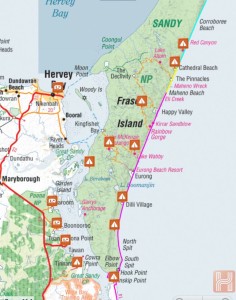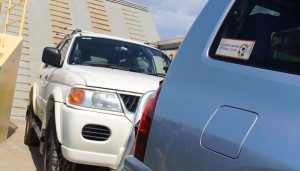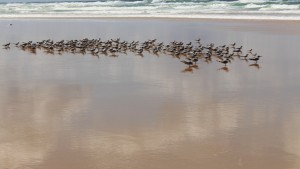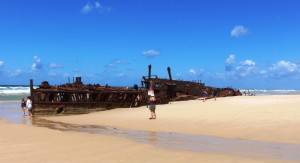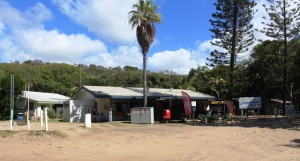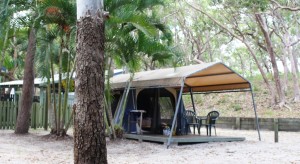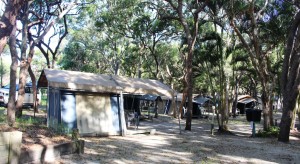It was an adventure just getting there!
We woke before the alarm’s set time. Five am! Too early, but when the timetable depends on tides then it is smart to know who is boss. And it wasn’t us. “Time and tide wait for no man”, Geoffrey Chaucer once wrote.
But the early start allowed us to drive out of our gate by about 6.30 am. After a stop for fuel and a call at the ATM we were on the sparsely populated north bound lanes of the Bruce Highway, a little before 7.00 am. The south bound lanes were another story, but someone else’s story.
The vehicular ferry to the south end of Fraser leaves from Inskip Point, about 10 km north of Rainbow Beach. That’s about 225 km north of home. We arrived at Rainbow Beach at about 9.30 am, treated ourselves to coffee, topped up the fuel, bought a ferry ticket, went through the car wash booth for a protective spray to be applied under the car and headed for the ferry departure point for that all important deflation of tyres for sand driving.
I had a great plan to video the ferry before we boarded, but as we approached it appeared to be fully load. But as we were about to stop the attendant waved us forward into the last remaining space. No sooner were we on board than the ramp was up behind us and the ferry was under way. The crossing only takes about 10 minutes ($6.00 per minute), and we were deposited onto the island. We paused to take the missed photos and by the time we were under way again all of our fellow passengers were out of sight.
If you are last off the ferry there is no one coming up behind you for a while so, all alone, we set off on the 80 kilometre drive along the beach. The beach first runs easy west but soon turns in a of north of north east direction. The beach is a series of small sandy bays but the dunes to your leafy stretch straight ahead as far as you can see. We did meet the occasional vehicle heading back towards the ferry.
There was a fair amount of cloud around, with the sun shining through most of the time and the sea that steely blue that often comes with those conditions. The sand was quite firm most of the time, except for when we were directed further up the beach at the places reserved for small passenger aircraft operation. The aircraft get the smooth flat parts and the motor
vehicle traffic is directed into the loose sand. But it was not too bad. Just a bit of slalom style driving for a few hundred metres as the tracks in the sand try to determine your direction.
Apart from aircraft and soft sand, the greatest hazard on Fraser is the frequent water courses that run across the beach into the sea. Rainfall is temporarily retained in the sand of the dunes but much of it makes its way to the edge of the beach and then through eroded sand banks to the sea. The sand embankments are most prominent and easy to see near the base of the dunes. From there they decline, depending on the height of the tides. So keeping one’s eyes open is mandatory. Crossing where the banks are too high can be quite disastrous.
But there are other traps. I was driving with my window open, savoring the fresh sea air. We crossed at the seaward end of a stream. It was a bit deeper than I thought and I drove through just a tad too quickly. The spray from the front wheel was caught by a rather brisk south easterly which blew it through the window all over me. Some of the spray even found its way onto Ruth. You may wonder if the water remains fresh right to the edge of the ocean. It does.
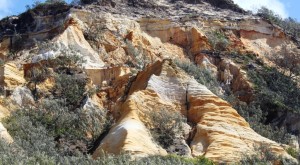
Part of The Pinnacles just south of Cathedrals on Fraser. One of the charms of this drive is the coloured sands
As we came north, we passed in order, Dilli Village, once the base of Dillingham Mining during sand mining days, now an education facility operated by the University of Southern Queensland; Eurong, the largest settlement on the island, with its resort and residential areas; Happy Valley, probably the second largest community on the island, with a general store, bistro and residential area; Eli Creek, the largest of all the beach streams; the remains of the SS Maheno passenger liner, resident on Fraser since the mid 1930s; and finally, Cathedrals on Fraser, our home for the next four nights.
We are accommodated in a permanent tent that boasts a double bed, a towel rack and two plastic chairs as the total compliment of its furnishings. Our possessions are in bags arranged along the walls. We prepare and eat our meals in a camp kitchen that has plenty of refrigeration and freezer capacity but this is supplemented by the Waeco 12 volt fridge in the back if the car.
In our immediate area, besides us, there are four family tents which between them contain eight adults and about 10 kids, most of who are between the ages of four and ten. So until their bed time there is not much peace and quiet. Their biggest impact however, is in the camp kitchen at meal preparation time. It is hard to get a look in when half a dozen adults are preparing food for a group of almost twenty. Washing up is a similar story.
I had forgotten that, in warm weather, when sleeping in a tent, a balance has to be struck between privacy and comfort. The only method of cooling is the breeze. Fortunately, on this coast, the sea breezes are reliable, so we spent the night largely on display through the insect screens, but no one was watching. We were awoken next morning by the early light. The aspect of the camp and our tent, was towards the east.

